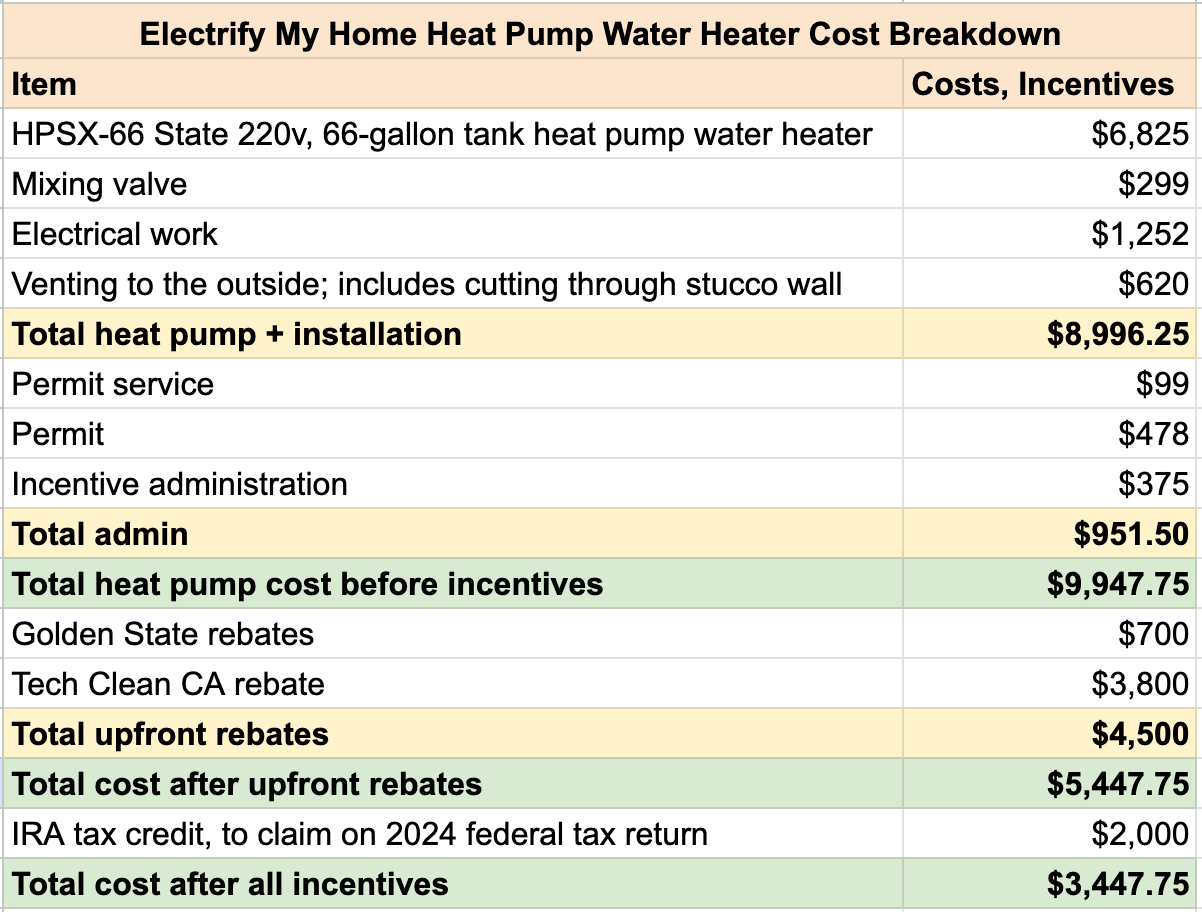I realize that not everyone comes here for details on home appliances. If you’re curious about heat pump water heaters, read on; if not, feel free to skip this post. (I know, you’re always free to skip reading these!) As a Flower Child, even unsexy climate actions like this are near to my heart — but I promise you that next week, I’m moving on to something completely different.
Last week, I took my first shower powered by solar energy. That was made possible by our newly installed electric heat pump water heater (or HPWH, as those in the biz call it), which runs on the electricity generated by our solar panels.
Getting to yes
When I wrote about HPWHs last November, we were still in the exploratory phase. It took us a while to get to that phase, because major appliances are expensive. But when we learned that some new incentives were coming to California, on top of the Inflation Reduction Act (IRA) tax credit, we knew it was time to move forward.
You can read about what HPWHs are and why we wanted to get one in that previous post. TL;DR: They run on electricity, are super efficient, and can save you money. Electrifying everything, along with switching our energy sources to cleaner ones, is key to fighting climate change.
But because the technology is relatively new in the United States (just one of many ways we’re behind many other countries, but that would take too long to get into here), there’s still a lot of confusion, complexity, and expense involved. So we really needed the new incentives, plus guidance from professionals as well as friends who’d already made the switch.
While we started our exploration with the awesome concierge service QuitCarbon, we ended up going with Electrify My Home for our HPWH. Their quote came in at over $1000 less, and I like that they provide more of a turnkey service rather than connecting you with contractors — plus, a friend had a good experience with them. I’m not familiar with services like these around the country, but if you’re in the Bay Area, these two are both good choices.
Cost breakdown
Every situation is different, so if you’re considering a HPWH, take our experience as just one example.
Costs for HPWHs vary widely around the country, and they happen to be on the high end where we live — just like everything else here, but hey, we can hike comfortably all year round and I don’t get hassled for wearing a mask in public.
In addition, our water heater is not tucked away in some unlived-in basement or garage. It’s in a finished partial basement that serves as Rafael’s office, aka The Lair. That meant our new HPWH needed certain mitigations that added to the cost, like a vent to send the cold air it generates out of the living area. It also required extra electrical work. On the other hand, we had enough space for the appliance, which is larger than our old gas water heater.
Here are the details on the costs and incentives:
We would have done better to schedule the installation at the end of last year so we could get the $2000 IRA tax credit this year, but we weren’t quick enough to fit it in. That just means we’ll have to wait another year for that tax credit.
At nearly $3500 after incentives, this is not a cheap device. But the rebates and credits slashed the upfront and total costs considerably, we’re one step closer to breaking up with fossil fuels, and we’ll be heating our water for almost nothing thanks to our solar panels. (The “almost” is because we still have to pay our local utility, PG&E, to be connected to their grid.) Our water heater was getting old, so we would have had to shell out some cash before long even if we hadn’t switched to a heat pump.
A new upfront HPWH rebate of up to $1750 is expected from the IRA sometime this year for income-qualified households, and your income doesn’t have to be as low as you might think to get it. Rafael and I would qualify, but we don’t know yet how or when it will be implemented in each state, and we wanted to jump on the larger California rebates available now. In this ever-changing landscape of incentives, it’s all the more crucial to have guidance from experts to navigate these.
Should you make the switch?
I can’t tell you if you should get a HPWH now, but chances are you will someday. Heat pumps in general are quickly gaining on gas appliances, their costs are bound to come down while fossil gas prices go up, and we all have to get off of fossil fuels. A new water heater is still a big expense, though.
How well do they work? It’s still too soon to tell how we’ll like our HPWH. So far, it seems fine — other than the added noise in Rafael’s lair. The fan and compressor in a HPWH make an unpleasant humming sound of around 50 decibels when the water is being heated. Rafael can mitigate the noise with sound-baffling curtains and also by changing the schedule to heat the water when he’s not in the lair, but that might not be an option for everyone; you might need to keep your HPWH on a specific schedule to qualify for some rebates or to keep your electricity costs low.
We have a handy app we can use to control the heat and schedule on our HPWH, and if you know me, you know I’m a sucker for home automation apps. We already had apps that let us see our solar panel production and control our heat, irrigation system, hot tub heater, and some light bulbs. If you don’t like apps, rest assured you can set the temperature manually.

The Demand Response option is useful if your utility has a demand response program, which encourages participants to make slight shifts in when they use energy to help reduce demand on the grid during peak hours. For example, you could run your air conditioner when energy demand is low to pre-cool your house and then turn it down a bit during peak hours; many demand response programs automate these shifts. If your utility varies what it charges based on when you use electricity, you can use the Time-of-Use option to set your water heater to heat during times when electricity from the grid is cheaper.
As you can see, there are all kinds of cool things you can do with an app!
Ultimately, though, whether or not we had an app, we just wanted reliable hot water. If we can get it more cheaply and powered by the sun, all the better.
This is the seventh in my electrification and renewables series. Previous posts:








Interesting and informative, thanks!
Great post. Thanks for explaining it all so well.